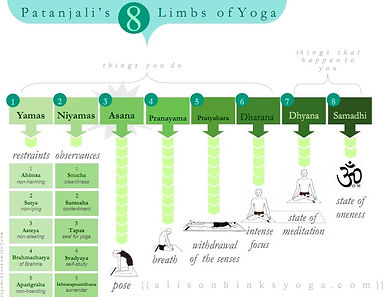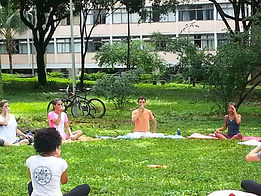
Yoga as it is
If you wish to have a personal Yoga practice, read the following directions with full attention and start practicing Yoga right now, being attentive with whatever you experience in the present moment.
While you read, observe if any thought, besides the content of the text, crosses your mind and takes your concentration away; if it does, start focusing on your thought and let the text aside, after a couple of seconds, come back to the text. Be aware at all times of all present events.
Whichever problem you have, attachments, lack of concentration, energy blockages or physical pains, the regular practice of Yoga heals or releases it. Right after the practice you already feel the improvement, however it soon fades away, because the issues we all have are usually chronicle. Therefore, a regular practice is necessary to eradicate them from the root.
We have to prepare a Sadhana – daily spiritual practice. Consistent results come from daily practice, even short ones, like 20/30 mins is enough.
Yoga has to be taken as a spiritual practice, even if it is to release your physical pain, so the results are more effective. Do never take Yoga as physical exercises. Yoga means connection, between yourself and God, between yourself and your true self. Connection with the present moment. How to do it?
Just being aware of any experience you are having right now, a sound, a sensation, a smell, pain, a thought…everything you are experiencing right now and you are aware of it, then you are living in the present moment…that is called mindfulness. Anything you think is disturbing your concentration, a loud sound, some pain, a repetitive thought that keeps on coming, focus on it instead of complaning or blaming. Then, as magic, it becomes the object of your meditation, so you connect with the present moment instead of letting it disturb you. Nothing can disturb us, no pleasure and no pain, everything has to be seen as a phenomenon, as an experience, as it is. It is what it is, it is not good nor bad, these are just evaluations of your mind. It is what it is.
A Yoga teacher does not teach the same for all students, and he does not teach the same all his life either. What he/she teaches evolves alongside with his own spiritual development. Therefore each person will have his own Sadhana; however it has a base and it follows Ashtanga Yoga – the eight paths of Yoga




1) Yama – 5 concepts – which must be put in practice as there is nothing theoretical in Yoga – regarding to the way you must deal with the environment.
1.1 Non-violence towards yourself; accept your limitations;
1.2 Non-speaking lies takes your speech to a higher level;
1.3 Non-stealing things and time from other makes you more self-confident;
1.4 Controlling of the eating, sleeping and sex patterns makes you calmer and helps to awake your energy;
1.5 Non-accumulation makes you have fewer problems;
2) Nyama – concepts regarding to the way you must deal with yourself
2.1 Purty in thoughts, speech and deeds;
2.2 Satisfaction or contentment with who and where you are;
2.3 Self discipline to follow the Sadhana;
2.4 Self-study to develop in(sights); you have to learn about yourself by observing all these yamas and nyamas. Writing the experiences you have in your Sadhana is very effective for that;
2.5 Surrender to God – focus on your effort not on the results of it, they are not on your hands.
All these points must be slowly put in practice. As you know, there are many `rules` a yogi must follow, as for example not eating meat and not masturbating; however all these practices must come into our daily life slowly, otherwise they will be just a short-term practice and the old habit will come back. Therefore if you eat meat, then slowly you will eat less and observe how you feel (study yourself). Along the process you must try things, for example: fasting; meditating for one full hour moving as less as possible; waking up at 4.30 to practice; chanting a mantra for 20 minutes; trying to write your dreams for a week. All these things, that you may do just once, will be very valuable for you to have in (sights).3) Asana – yoga postures
4) Pranayama – breathe exercises
5) Pratyahara – withdraw of the senses or relaxation
6) Dharana – practices to develop the concentration, such as mantras and candle gazing
7) Dhyana – there is not effort to experience meditation – which means becoming one with the object of concentration –, the effort is put on concentration, which will naturally leads you to a meditative state. Buddhist meditation practices will be explored.
8) Samadhi – the aim of the Yoga practice. Reaching Yoga, to be fully connected with yourself and with God. Therefore, yoga is the process and the final goal.Doubts will come my dear friends, this is part of the spiritual path. Let them come and keep focusing on your Sadhana, and not on the results of it; which will also come.

